Sustainable Chemistry Implementation Guide Section 3: Advancing Safer Formulation
1. By 2022, Walmart aims to reduce its consumables chemical footprint for applicable products in Walmart stores and Sam’s Clubs in the U.S. by 10 percent. Suppliers are encouraged to reduce, restrict and eliminate use of Walmart Priority Chemicals using informed substitution principles.
Description
10 Percent Priority Chemical Consumables Chemical Footprint Reduction Goal
- By 2022, Walmart aims to reduce its consumables chemical footprint for applicable products in Walmart stores and Sam’s Clubs in the U.S. by 10 percent.
- The baseline for comparison will be 2017 results, shown below. A new baseline was used in 2017 because the 2014 baseline did not include the two regulatory and authoritative lists that were added to the Walmart Priority Chemical list in 2016.
- All suppliers are encouraged to reduce, restrict and eliminate use of Walmart Priority Chemicals using informed substitution principles.
- The list of authoritative and regulatory lists Walmart uses to identify Walmart Priority Chemicals within the scope of this commitment can be found in Appendix 1.
Informed Substitution
Informed substitution is “the considered transition from a chemical of particular concern to safer chemicals or non-chemical alternatives.”1 Walmart advocates use of informed substitution principles to mitigate, reduce, and eliminate potential hazards associated with product formulations. Per Walmart Compliance procedures, a new UPC/GTIN must be issued on products that have changes to formulation or composition. For additional information on UPC change requirements, please go to the Walmart Compliance website.
In the aim of advancing safer formulated products and promoting informed substitution, Walmart embraces the major tenets of Alternatives Assessment, “a process for identifying, comparing and selecting safer alternatives” to Walmart Priority Chemicals “(including those in materials, processes or technologies) on the basis of their hazards, performance, and economic viability.”2
The Commons Principles of Alternatives Assessment are reproduced here:3
- Reduce hazard
- Minimize exposure
- Use best available information
- Require disclosure and transparency
- Resolve trade-offs
- Take action
Walmart encourages its suppliers to use methods, databases, and lists such as the ones listed in Appendix 3 (Guides for Alternatives Assessment) on their journey to reduce and eliminate Walmart Priority Chemicals using informed substitution. Walmart also welcomes innovative products that have been certified or screened by programs that clearly state continuous improvement and informed substitution as program principles, such as the U.S. Environmental Protection Agency's Safer Choice Labeling Program.
Resources
- See Appendix 1 for Walmart’s Priority Chemical list, a list of authoritative and regulatory reference lists
- See Appendix 3 for a non-exhaustive list of guides for alternatives assessment aligned with The Commons Principles of Alternatives Assessment that suppliers may use in their efforts to advance safer formulation of products using informed substitution.
Measurement
- Walmart will track chemicals from Walmart’s Priority Chemical list (excluding the Sourcing Action List chemicals (SALs) on Appendix 7) against its goal of reducing Walmart’s Consumables Chemical Footprint for certain products by 10% by 2022.
- Walmart will separately measure SALs that have been verified to meet purity standards (see B.3. for more information). The function was made available via the WERCSmart system in 2020, so we will begin reporting against them in 2021.
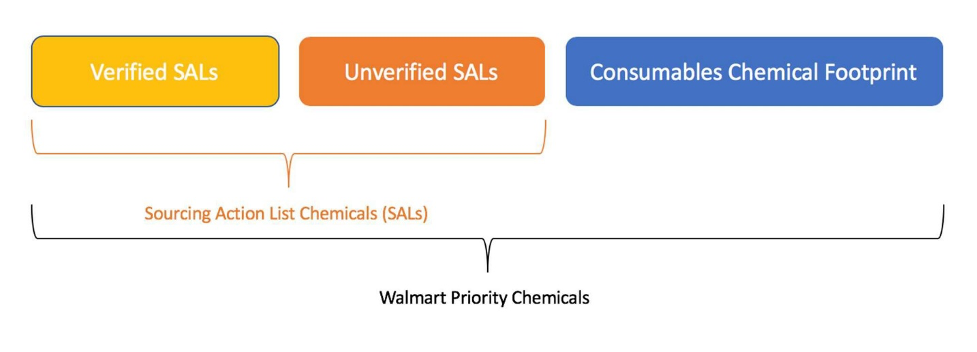
Walmart will track the policy elements in this section using the metrics listed in the table below and information from UL.
The metrics below capture the reduction of Walmart Priority Chemicals within our Consumable Chemical Footprint by weight volume, the restriction and elimination of Walmart Priority Chemicals within our Consumable Chemical Footprint by percentage of UPCs, and by number of suppliers. To capture this data, Walmart shares internal sales data from Retail Link to UL. UL’s WERCSmart system combines that data with formulation data submitted by suppliers, who granted at least Tier 2.1 access to Walmart.
Note: There are external variables - such as expansion of product offerings, sales fluctuations of products containing Walmart Priority Chemicals, and the addition of new ingredients to regulatory and authoritative lists - that can impact the increase or decrease of the numbers shown. Additionally, as Walmart continues to encourage suppliers to grant permission to UL WERCSmart’s Tiers 2.1 and 2.2, these numbers may increase and decrease as additional supplier information becomes available. While not perfect, we use these metrics to help us assess progress towards our goal of a reduction in our Consumables Chemical Footprint.
Reduce Volume of in-scope Walmart Priority Chemicals in Our Consumables Chemical Footprint
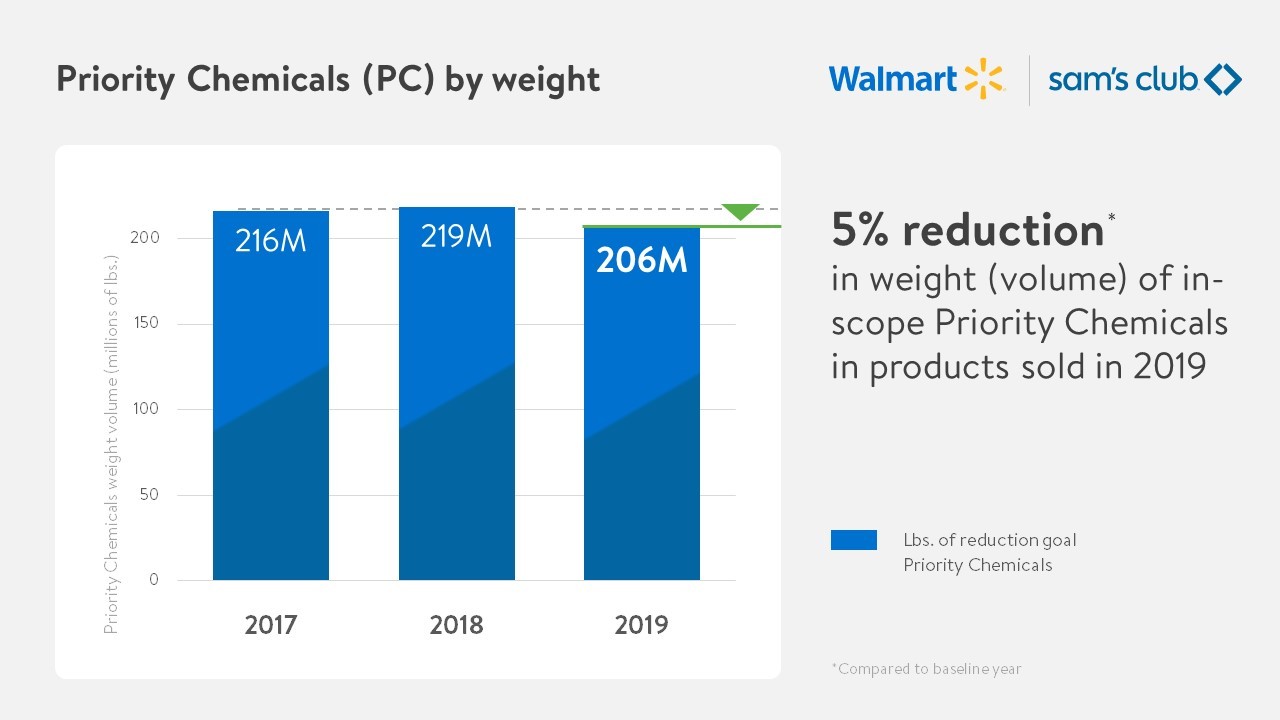
The 2018-year results included combined in-scope Walmart Retail Link data sales collected in January 2019 (sales data from January 1st 2018 through December 31st 2018) and submitted formulation data from in-scope suppliers to the WERCSmart system as of Oct. 21, 2019. The percent of UPC volume weight disclosure in both the baseline year and year of measurement remained materially the same.
Our baseline year chemical footprint combined for Walmart and Sam’s Club U.S. stores was restated from 220.8 million pounds of priority chemicals (PC) weight to 215.9 million pounds of PC weight based on formulations that our suppliers inadvertently assigned to the wrong UPC registrations in UL’s WERCSmart system. We updated the baseline to report the correct progress on our reduction goal. Our baseline number is based upon 65% of UPC volume weight disclosed through the WERCSmart system. In any given year, an increase or decrease in UPC volume weight disclosures may impact reporting.
Combined Walmart and Sam’s Club U.S.
Restrict and Eliminate in-scope Walmart Priority Chemicals in Our Consumables Chemical Footprint
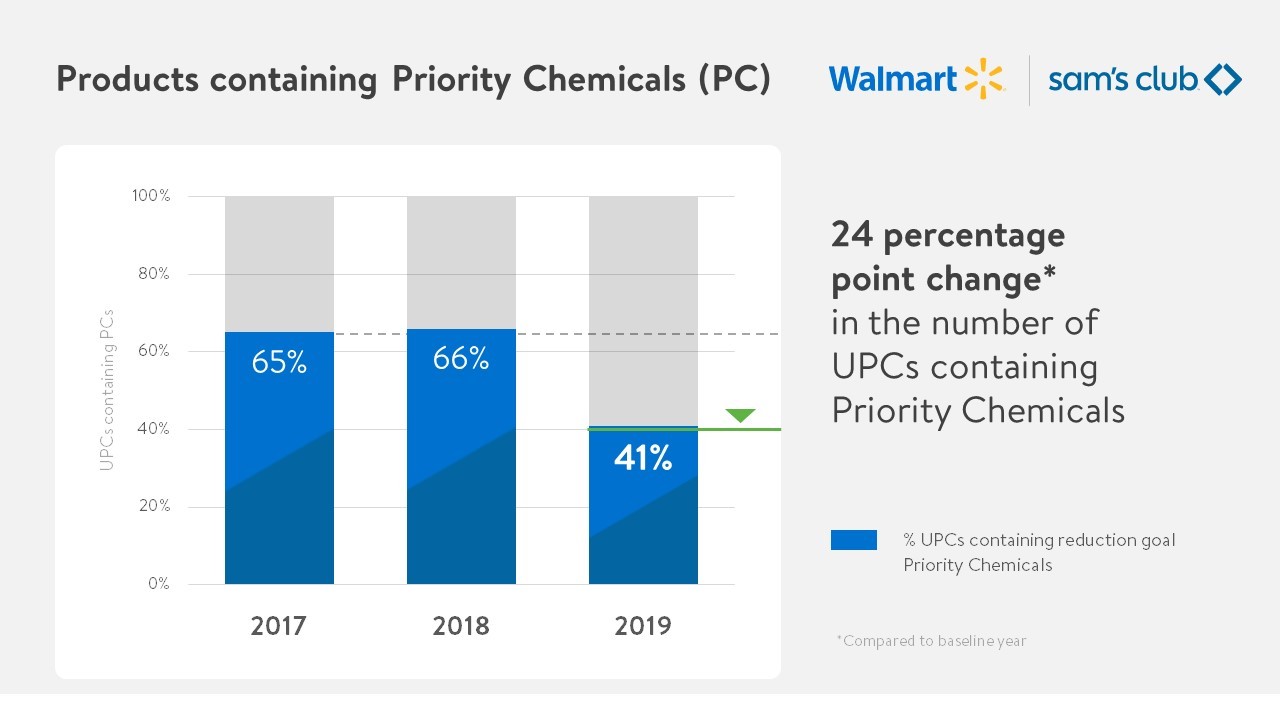
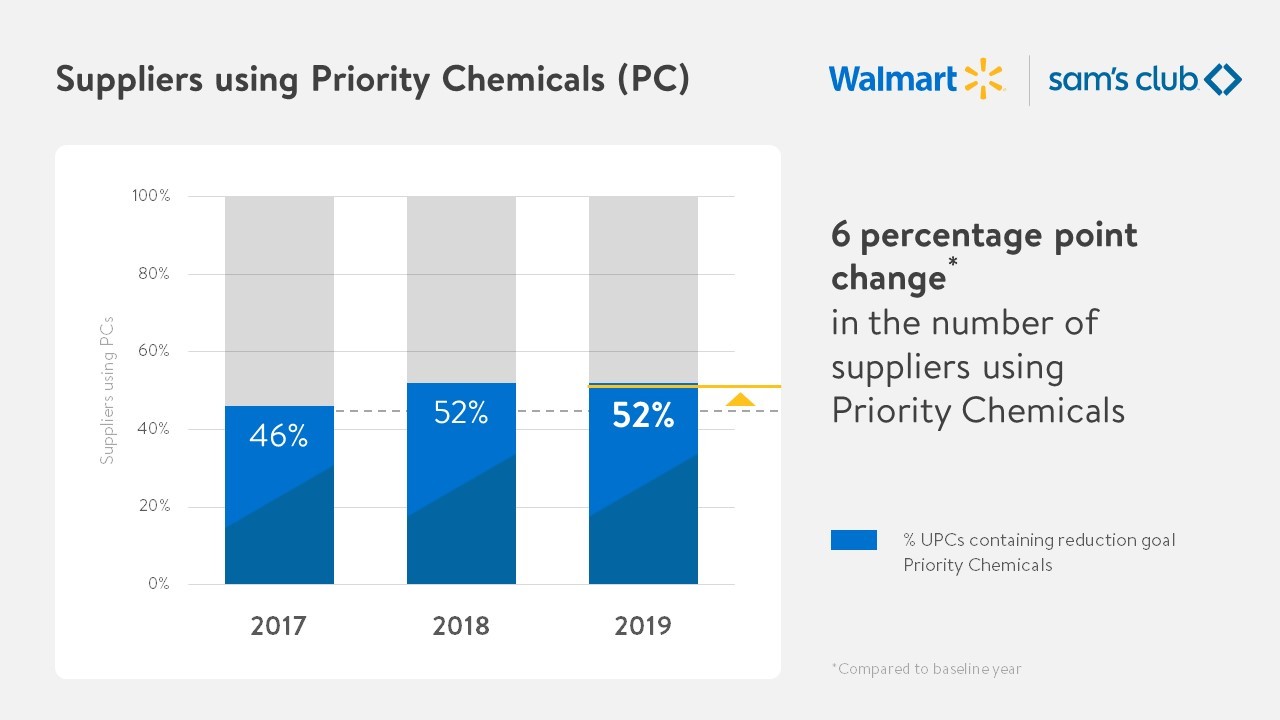
Walmart has also started tracking the reduction of the weight of priority chemicals as a proportion of total product formulation weight. This additional metric helps provide a more complete assessment of Walmart’s progress against our chemical footprint reduction goal as overall sales volume varies year over year. Walmart will continue to strive to reduce the absolute volume of in-scope PCs to meet our 10% chemical footprint reduction goal. Proportional Weight Volume of in-scope PCs: Weight Volume of in-scope PCs ÷ Total Weight Volume of in-scope Formulated Products.
Combined Walmart and Sam’s Club U.S.
Reduce Volume of in-scope Walmart Priority Chemicals in Our Consumable Chemical Footprint
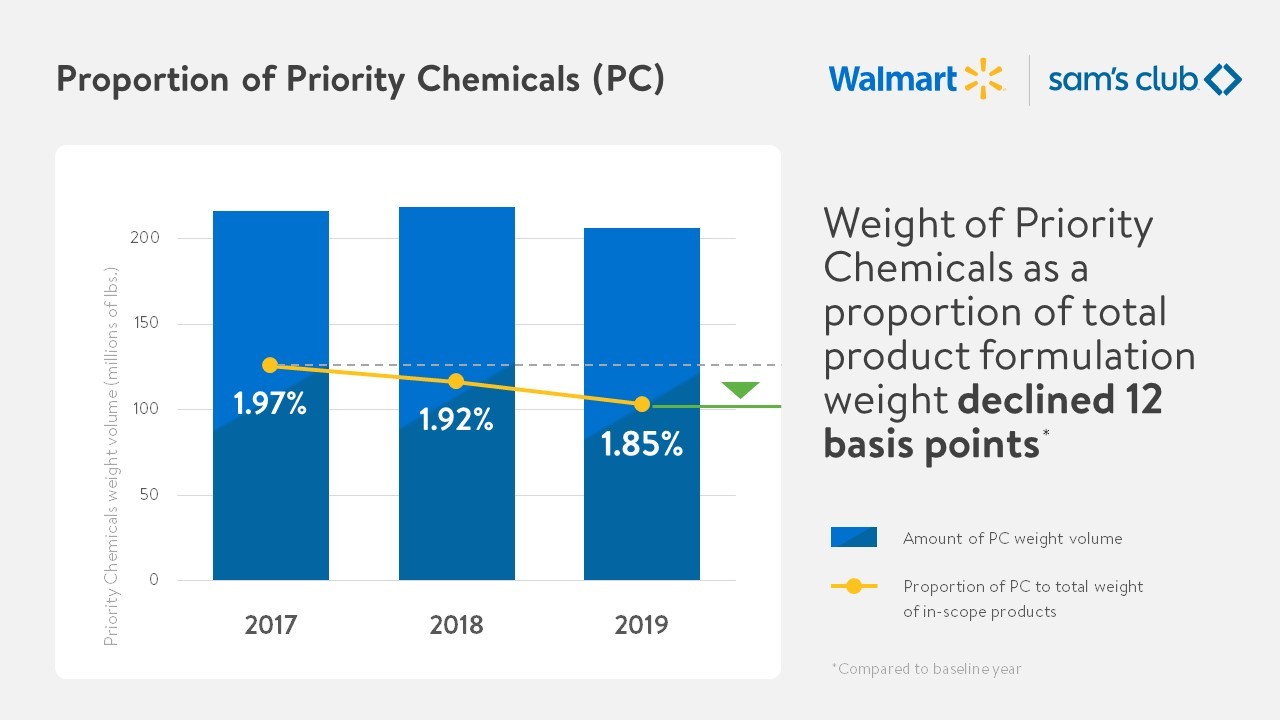
The 2018-year results included combined in-scope Walmart Retail Link data sales collected in January 2019 (sales data from January 1st 2018 through December 31st 2018) and submitted formulation data from in-scope suppliers to the WERCSmart system as of Oct. 21, 2019. The percent of UPC volume weight disclosure in both the baseline year and year of measurement remained materially the same.
2. Walmart suppliers are encouraged to verify purity of ingredients where Contaminants of Concern may exist. From among Walmart Priority Chemicals, Walmart stores and Sam’s Clubs in the U.S. have identified a subset of Sourcing Action List chemicals (SALs). These chemicals will be measured separately from Walmart’s 10% Walmart Priority Chemical Reduction Goal in our Consumables Chemical Footprint.
Description
From among Walmart Priority Chemicals, Walmart and EDF have identified a subset of Sourcing Action List chemicals (SALs), which are petroleum-based chemicals that have been identified because of the potential presence of contaminants of concerns, as indicated by regulatory and authoritative bodies. Suppliers can verify their SALs do not contain any Priority Chemicals when UL’s WERCSmart system measurement enhancements are available.
Measurement
Suppliers will be able to provide verification information when entering formulation data into UL’s updated WERCSmart system. Walmart will track both verified and unverified SALs by weight volume, number of UPCs, and number of suppliers. Verified SALs metrics will be included in the upcoming report. This data will be available for the 2020 measurements.
3. High Priority Chemicals
We no longer report on HPCs, as they are now included within the comprehensive list of Walmart Priority Chemicals.
1 U.S. EPA. 2015. U.S. EPA's Safer Choice Standard (formerly, the ‘DfE Standard for Safer Products’)
2 Chemical Commons. 2013. The Commons Principles for Alternatives Assessment.
3 Ibid



